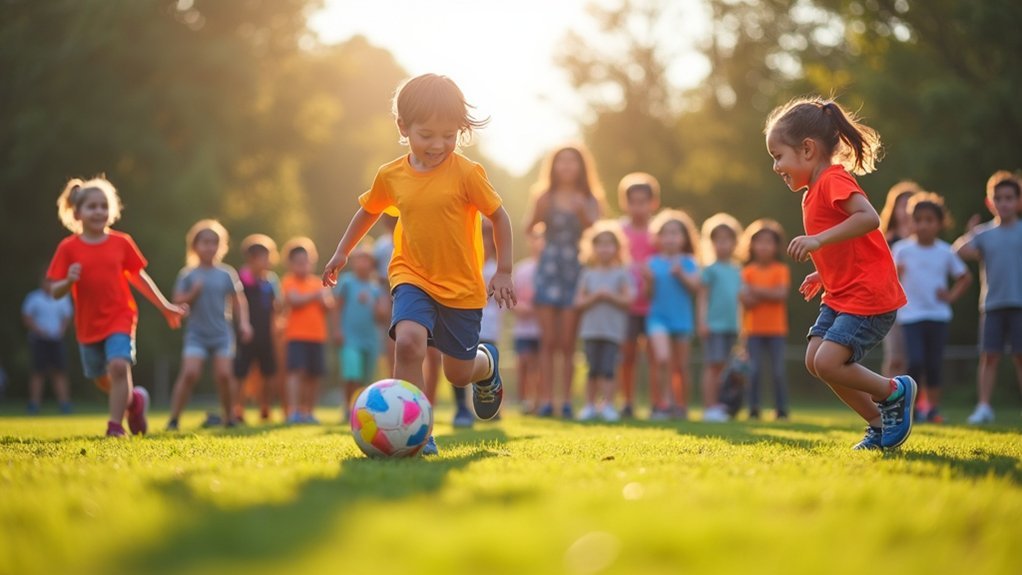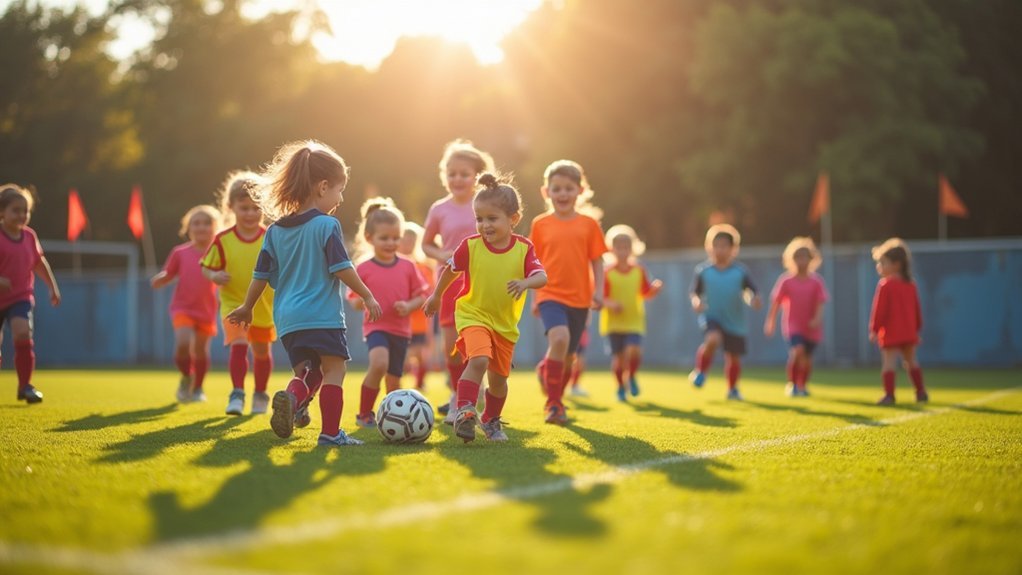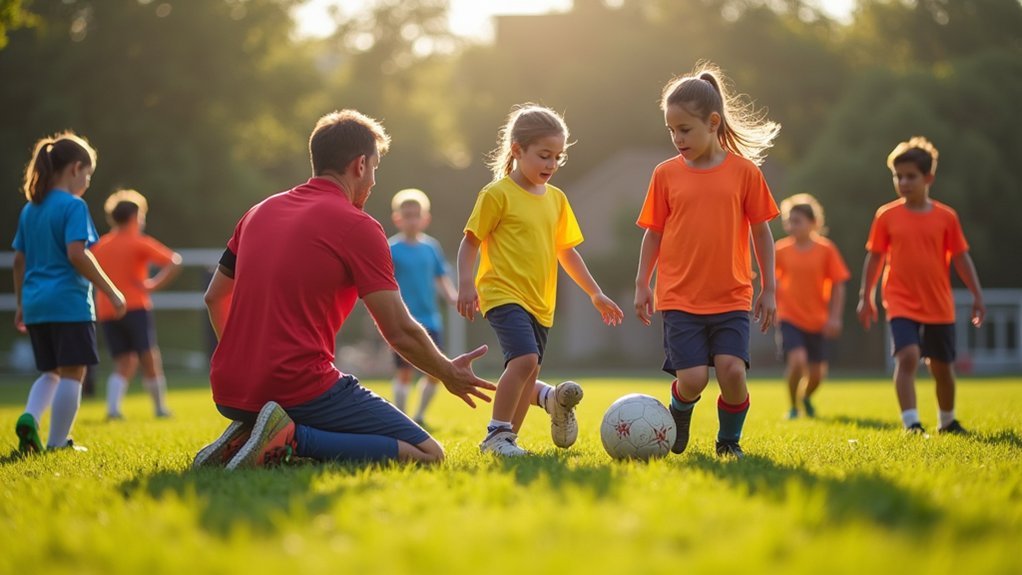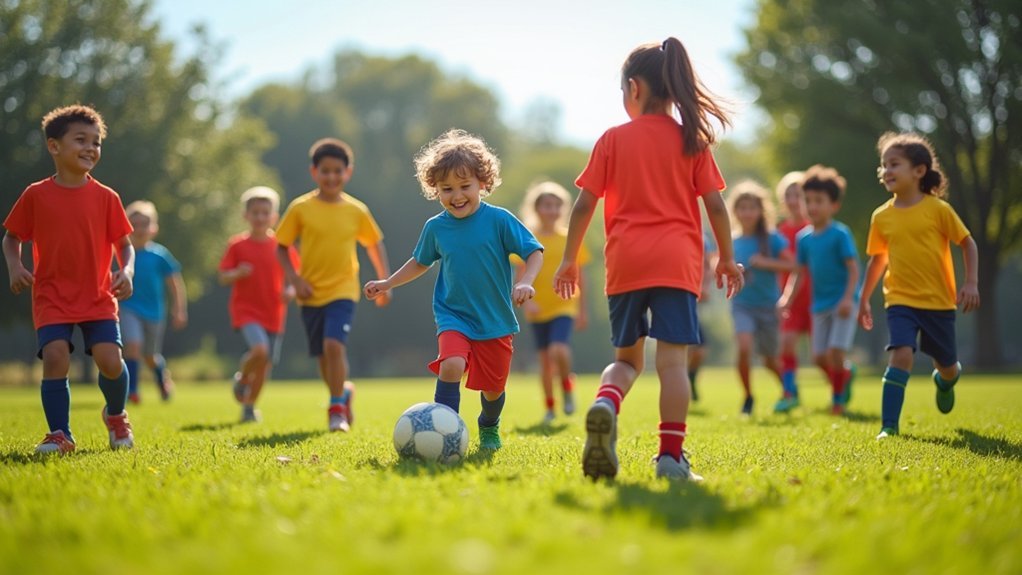Team sports offer powerful benefits for autistic individuals, building social skills in structured environments while providing physical activity. Choose sensory-friendly options like swimming or bowling, and adapt equipment with noise-canceling headphones or softer balls. Create predictable routines, use visual aids, and establish buddy systems to enhance participation. Recognize individual achievements to boost self-esteem within inclusive team settings. The right combination of sport selection and accommodations can transform team participation into a foundation for lifelong success.
Understanding the Benefits of Team Sports for Autism Development

Inclusion opens powerful doors for children with autism through team sports participation. When your child joins inclusive sports programs like Special Olympics Unified Sports®, they gain opportunities to develop essential social engagement skills in structured environments that align with their preference for routine and predictability.
Team sports unlock new worlds for children with autism, providing structure, routine, and a safe space to build crucial social connections.
Team sports provide the perfect setting for your child to form meaningful friendships while learning collaboration with peers.
Beyond social benefits, physical fitness gained through regular activity directly contributes to improved behavioral outcomes, enhanced academic performance, and overall well-being.
You’ll likely notice decreased sedentary behavior, which helps combat obesity and related health complications.
The combination of physical activity, social interaction, and structured play creates a powerful developmental environment where children with autism can thrive both physically and emotionally.
Selecting Appropriate Team Sports Based on Individual Sensory Needs
When selecting team sports for individuals with autism, you’ll need to take into account their unique sensory needs first, as activities with overwhelming stimuli can create barriers to participation.
Look for sensory-friendly options like swimming or martial arts that offer controlled environments with predictable routines, and don’t hesitate to incorporate adaptations such as noise-canceling headphones or modified uniforms.
You can match your loved one’s interests with appropriate sporting environments by actively collaborating with coaches and caregivers to identify specific preferences and implementing necessary accommodations.
Sensory-Friendly Sport Options
Selecting the right team sport for individuals with autism requires careful consideration of their unique sensory profiles.
You’ll find that sensory-friendly sports like swimming and bowling provide controlled environments that minimize overwhelming stimuli while encouraging participation and physical activity.
Therapeutic horseback riding offers a calming experience that addresses sensory sensitivities through gentle movement and connection with animals.
Martial arts, with their structured nature and clear routines, create predictable experiences that many individuals with autism find comforting.
When exploring inclusive environments, consider using specialized equipment such as soft-textured gear or noise-canceling headphones to enhance comfort.
Always collaborate with caregivers and professionals to assess individual needs before selecting a sport.
This personalized approach guarantees participants can enjoy the social benefits of team activities while respecting their sensory requirements.
Matching Interests With Environment
Finding the perfect match between an individual’s interests and their sensory needs creates the foundation for successful athletic participation.
When selecting team sports for individuals with autism, you’ll want to take into account both engagement potential and environmental factors. Collaborating with caregivers helps identify individual preferences and specific sensory sensitivities that might impact participation.
- Choose controlled environments like swimming or bowling that offer predictability while minimizing overwhelming sensory stimuli.
- Incorporate sensory-friendly equipment such as noise-canceling headphones or specialized sports gear with textures comfortable for the participant.
- Create a supportive team environment that respects each person’s unique sensory profile while encouraging social connection.
Creating Structured Environments for Successful Team Participation

The foundation of inclusive team sports for individuals with autism rests on thoughtfully designed environments that address their unique sensory and communication needs.
You’ll find that structured environments with designated quiet zones help minimize sensory overload by managing bright lights and strong odors that can overwhelm athletes with autism.
Implement clear communication strategies using straightforward language and visual aids to enhance understanding during team activities.
Visual support bridges the verbal gap, making instructions accessible to all team members regardless of communication differences.
Breaking tasks into smaller steps accommodates different learning styles, making participation more manageable.
Consider establishing buddy systems that pair athletes with supportive peers, fostering natural social interaction during practice.
For an inclusive experience, tailor activities to individual strengths and interests.
When you design sports programs that respect sensory sensitivities while building on personal capabilities, you’ll create team participation opportunities where everyone can thrive.
Training Coaches and Teammates for Autism-Inclusive Practices
When coaching athletes with autism, you’ll need to adapt your communication style by using clear, concise instructions paired with visual demonstrations that minimize potential sensory overload.
You can foster team understanding by implementing simple visual cues, social stories, and consistent routines that help autistic players navigate team dynamics more effectively.
Training yourself and your team to recognize sensory triggers during practices and games will create a more supportive environment where all athletes can thrive regardless of their neurological differences.
Communication Strategies That Work
Effective communication forms the cornerstone of successful autism-inclusive sports programs. When working with athletes on the spectrum, you’ll need to adapt your communication approach to guarantee everyone can participate fully and confidently.
- Use visual aids like charts and diagrams alongside verbal instructions to create clear expectations and enhance understanding for athletes who process information differently.
- Speak using straightforward language and break down complex instructions into smaller, manageable steps that athletes can follow sequentially.
- Create a sensory-friendly environment with quiet zones and reduced stimuli to help decrease anxiety and improve focus during practice and games.
Maintaining consistent communication with caregivers about individual preferences allows you to tailor your approach, building a supportive environment where social conventions can be explicitly taught and peer interactions naturally fostered.
Sensory-Aware Coaching Techniques
Successfully integrating athletes with autism into team sports requires coaches to develop sensory-aware techniques that address unique processing needs.
Start by creating environments that minimize sensory overload—reduce noise, control lighting, and establish quiet zones where athletes can decompress.
Adapt activities to match individual needs by breaking skills into manageable steps and using clear communication supported by visual aids. These coaching techniques help athletes process instructions more effectively while building confidence.
Train teammates about autism to foster an inclusive atmosphere where everyone understands and supports each other. This education and awareness promotes positive social interactions and genuine teamwork.
Remember that each athlete’s sensory preferences differ—some may struggle with loud whistles while others need structured changes.
Your flexibility in coaching approaches will maximize participation and enjoyment for all players.
Adapting Communication Strategies in Team Settings

How can coaches create truly inclusive team environments for athletes with autism? Start by using clear communication with straightforward language to reduce confusion. Pair this with visual aids like charts and diagrams that supplement verbal instructions, making concepts more accessible for all team members.
Establish consistent routines to minimize anxiety, and always provide advance notice when changes occur. This predictability creates a foundation for successful engagement in team activities.
- Create teammate buddy systems to model appropriate social interaction behaviors
- Develop customized visual playbooks that break down complex team strategies
- Maintain regular dialogue with caregivers to understand individual communication preferences
Modifying Equipment and Rules for Sensory-Friendly Play
Customizing your team’s equipment with softer balls, larger targets, or tactile gear creates a sensory-friendly environment where athletes with autism can thrive.
You’ll find that implementing simplified rules, such as allowing extra changeover time or modified game structures, helps players engage confidently without feeling overwhelmed.
These thoughtful adaptations don’t diminish the competitive spirit of the game but instead guarantee everyone can participate meaningfully regardless of their sensory processing needs.
Modified Equipment Solutions
Equipment modifications serve as gateways to inclusive sports participation for athletes with autism. By thoughtfully adapting sports equipment, you’ll create sensory-friendly modifications that make team activities more accessible and enjoyable.
Consider the sensory stimulation needs of each participant when selecting modified equipment to foster a supportive atmosphere where everyone can succeed.
- Use softer, lightweight balls that move more slowly through the air, reducing anxiety and increasing reaction time for players.
- Implement brightly colored or textured equipment to provide positive sensory stimulation and make tracking objects easier.
- Utilize larger targets or goals to build confidence and create early success experiences.
These adjustments, combined with a buddy system for social interaction support, transform standard sports into inclusive environments where teamwork flourishes and participation increases naturally.
Simplified Rule Adaptations
While preserving the spirit of competition, simplified rule adaptations create inclusive pathways for athletes with autism to fully engage in team sports.
You’ll find that modifying game rules creates a sensory-friendly environment where players can thrive without feeling overwhelmed.
Consider allowing extra time for shooting or passing to accommodate different motor skills and reduce anxiety.
Implement visual aids like color-coded zones or illustrated charts to enhance communication and understanding of game rules.
These adaptations help players process information at their own pace.
Don’t forget to establish quiet zones where athletes can retreat during sensory overload.
These brief breaks prevent frustration and promote continued participation.
Building Social Skills Through Team Sport Progression
As individuals with autism engage in structured team sports, they develop essential social skills that extend far beyond the playing field.
You’ll notice significant improvements in communication and engagement as your child participates in inclusive sports programs like Special Olympics Unified Sports®, where athletes with and without disabilities collaborate toward common goals.
This progression in social development typically includes:
- Initial participation in structured team environments reduces anxiety while building self-esteem
- Regular interaction with teammates creates opportunities for meaningful friendships to form
- Consistent exposure to collaborative activities helps them understand and navigate social expectations
The benefits of team sports for autism extend well beyond physical fitness—they’re powerful tools for developing lasting social connections and interpersonal skills that contribute to success in all areas of life.
Managing Transitions and Expectations During Team Activities
Successfully maneuvering team activities requires thoughtful preparation for individuals with autism, who often find changes particularly challenging. Establish a predictable routine for practices and games to minimize anxiety and enhance comfort and engagement.
Use visual aids and social stories to clearly communicate expectations, helping athletes understand the sequence of events before they occur.
Visual tools and social narratives create predictable frameworks that empower autistic athletes to anticipate and understand upcoming activities.
When managing changes between activities, provide advance notice of any schedule alterations. This preparation time is essential for athletes to mentally adjust.
Create quiet zones at team events where participants can retreat if experiencing sensory overload. Practice specific change scenarios, like moving from warm-ups to gameplay, so athletes develop familiarity with these shifts.
These strategies guarantee team members with autism feel supported while developing the confidence to participate fully.
Celebrating Individual Achievements Within Team Contexts
Three key elements transform team sports into truly empowering experiences for athletes with autism: recognition, personalization, and meaningful celebration.
When you highlight individual achievements within team contexts, you create inclusive environments that boost self-esteem and foster a genuine sense of belonging.
- Special Olympics exemplifies this approach by honoring personal growth alongside team participation, creating spaces where athletes with autism feel valued for their unique contributions.
- Recognize specific skill improvements or demonstrations of sportsmanship to reinforce positive behaviors and motivate continued engagement.
- Encourage peer support by celebrating individual milestones during team gatherings, which naturally builds camaraderie between athletes with and without disabilities.
These celebrations aren’t just about acknowledging success—they’re powerful tools that strengthen social connections and affirm each athlete’s important role within the larger team framework.
Connecting Team Sports to Everyday Life Skills Development
The value of team sports extends far beyond the field or court for athletes with autism. When your child participates in inclusive environments, they’re developing essential everyday life skills. Through structured interactions with teammates, they practice communication and teamwork that transfers to school, work, and family settings.
You’ll notice how the routine of regular practice helps establish predictable patterns that individuals with autism often find comforting. The physical activity component delivers dual benefits—improving overall health while enhancing focus and behavior in daily situations.
Perhaps most importantly, these team experiences build self-esteem as your child overcomes challenges alongside peers. The social skills acquired—taking turns, sharing equipment, celebrating others’ successes—create a foundation for meaningful relationships and independence in numerous real-world contexts.
Frequently Asked Questions
What Sport Is Best for Autism?
The best sport for autism varies by individual. You’ll find success in swimming’s calming effects, bowling’s structure, therapeutic horseback riding’s sensory benefits, martial arts’ discipline, or team sports’ social opportunities. Choose what fits your preferences.
Do Autistic People Like Team Sports?
Many autistic people do enjoy team sports. You’ll find preferences vary widely – some love the structure and camaraderie teams provide, while others may prefer individual activities where social demands aren’t as intense.
What Is the Multidisciplinary Team for ASD?
A multidisciplinary team for ASD includes professionals like psychologists, speech therapists, occupational therapists, and special educators who’ll work together with your family to create personalized interventions addressing your child’s unique needs and strengths.
What Is the Best Sport for Autism Adults?
The best sport for adults with autism varies by individual preferences. You’ll thrive in structured activities like swimming, martial arts, or bowling. Consider your sensory needs and choose sports offering predictable environments and manageable social interaction.
In Summary
You’ve now got everything you need to help someone with autism thrive in team sports. Remember, it’s not about changing who they are, but creating environments where they’ll succeed. With proper adaptations and support, you’ll see growth in social skills, self-confidence, and life skills that extend far beyond the playing field. The journey may have challenges, but the rewards you’ll witness are immeasurable.





Leave a Reply